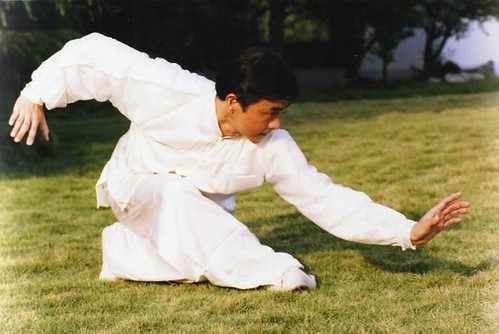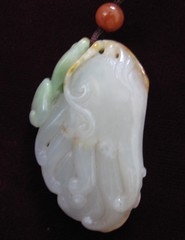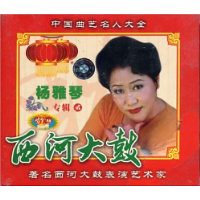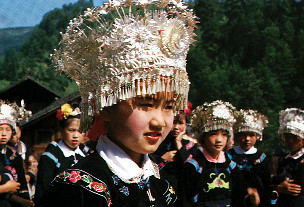| Home > Living in China > Kungfu |
Yi Chuan
 |
Yi Quan or the mentality Chuan, also called Da cheng Quan, was created by Wang Xiangzhai during the reign of Emperor Guangxu (1875-1908) of the Qing Dynasty. Wang (1885-1963) was born in Shenxian County in Hebei Province. From a young age, he followed Xingyi Quan master, Guo Yunshen to learn the art. After years of hard practice, Wang mastered the art of Xingyi Quan, got its gist, and ventured off the track to create Yi Quan by absorbing the suppleness of Tai Chi Quan, and the agility of Bagua Zhang.
Yi Quan centers on standing stances and uses the mind to guide the movements and actions in order to achieve the coordination and cooperation between the mind, the body and the external world. It stresses the development of energy and potential of the human body. The mentality boxers believe that looseness and tightness form the basic contradiction of the movements of the human body. The physical qualities-power, speed, agility, coordination and endurance-are all conditioned by the looseness and tightness of the muscles. Yi Quan, therefore, is intended to solve the question of how to correctly control and use looseness and tightness through practice. When we talk of looseness or tightness, we talk not only of loose or tight muscles but also of a loose or tight mind. The latter is in fact more significant. Therefore, this style of Chuan came to be called the mentality Chuan (Yi Quan).
The major features of mentality Chuan lie in the fact that it does not have fixed routines and that it stresses mental function. It requires relaxation, concentration and calmness-its movements are like running water, while its standstills are like floating air. It passes explosive forces throughout the body. Mentality boxers do not expose their bodies to the attacks of the opponent during a fight, nor do they display their thoughts. They seldom generate power but when they do they do it completely and thoroughly and often benefit from the force of the opponent .
Yi quan , also known as dacheng quan, is a martial art system which was founded by the Chinese xingyiquan master, Wang Xiangzhai (王向?.
History
Having learnt xingyiquan with Guo Yun Shen in his childhood,[citation needed] Wang Xiangzhai became a skilled fighter, who spent years travelling all over China, meeting and comparing skills with masters of various styles of kung fu.[citation needed] In the middle of the 1920s, he came to the conclusion that xingyiquan too often was taught wrong, with too much emphasis on 'outer form', neglecting the essence of true martial power. And so he worked to return to what he felt was the true essence of the art using a different name, without the 'xing' (meaning form), and began teaching and practicing it accordingly.
The style
Yiquan is essentially formless, containing no fixed sets of fighting movements or techniques. Instead, focus is put on developing ones natural movement and fighting abilities through a system of training methods and concepts, working to improve the perception of one's body, its movement, and of force. Another thing that sets yiquan apart from other eastern martial arts, is that traditional concepts, like qi, meridians, dan tien etc. eventually were discarded to make place for new explanations and ideas rooted in Western science, medicine and psychology. Much of this came about due to one of Wang Xiangzhai's key philosophies, which was that yiquan was a science of martial arts, and that there always would be room for improvement. If new methods or explanations are found that help produce better results faster, they should be adopted.
In 1939 an invitation was published, by Wang, in a Beijing newspaper[citation needed] for all martial arts masters to come and exchange experiences and ideas, which usually ended up in comparing skills. If anyone was to fight with Wang, though, they would first have to defeat one of four students he had appointed to fight for him, which no one who answered the challenge did.[citation needed]
Yiquan seems to have been influenced by various other arts that Wang was exposed to, include Fujian hèquán and bāguàzhǎng,.
Overview
The actual training in yiquan can generally be divided into:
Zhan zhuang (站樁) - Motionless postures, where emphasis is put on relaxation, working to improve perception of the body and on developing Hunyuan Li, or "all round force". Zhan zhuang can also be divided into two different types of postures; health postures and combat postures.
Shi li (试力) - Slow moving exercises, trying to bring the sensations developed through zhan zhuang into movements.
Moca bu (摩擦? - Shi li for the legs.
Fa li (发力) - Exercises that teach the use of explosive force.
Shi Sheng (试声) - Breathing exercises, including shouting ("testing sound")
Tui shou (推手) - (Pushing hands) Shi li with a partner.
San shou (散手) - Free fighting practice. (Also known as San Da)
Duan shou (断手) - Fighting techniques, including strikes and kicks.
Schools
Two of the foremost people teaching modern yiquan are Yao Chengguang (姚承? and Yao Chengrong (姚承?, twin sons of Yao Zongxun (姚宗?, whom Wang Xiangzhai appointed to be his successor. Others include Cui Ruibin of Beijing and students of the late Wang Xuanjie. Other schools include the Han Sing Yuen(韩星? School, which is the most popular school of Yiquan in Hong Kong,[citation needed] and the Li Jiang Yu (李见? School and Han xing Kiu (韩星?School.
Art
 more
moreChina Jade History
The Chinese regard carved jade objects as intrinsically

Chinese Traditional Art---- Xihe
Famous Star of Xihe Dagu---Yangyaqin Xihe

The Romance of butterfly lovers

Customs
 more
more



 print
print  email
email  Favorite
Favorite  Transtlate
Transtlate 
